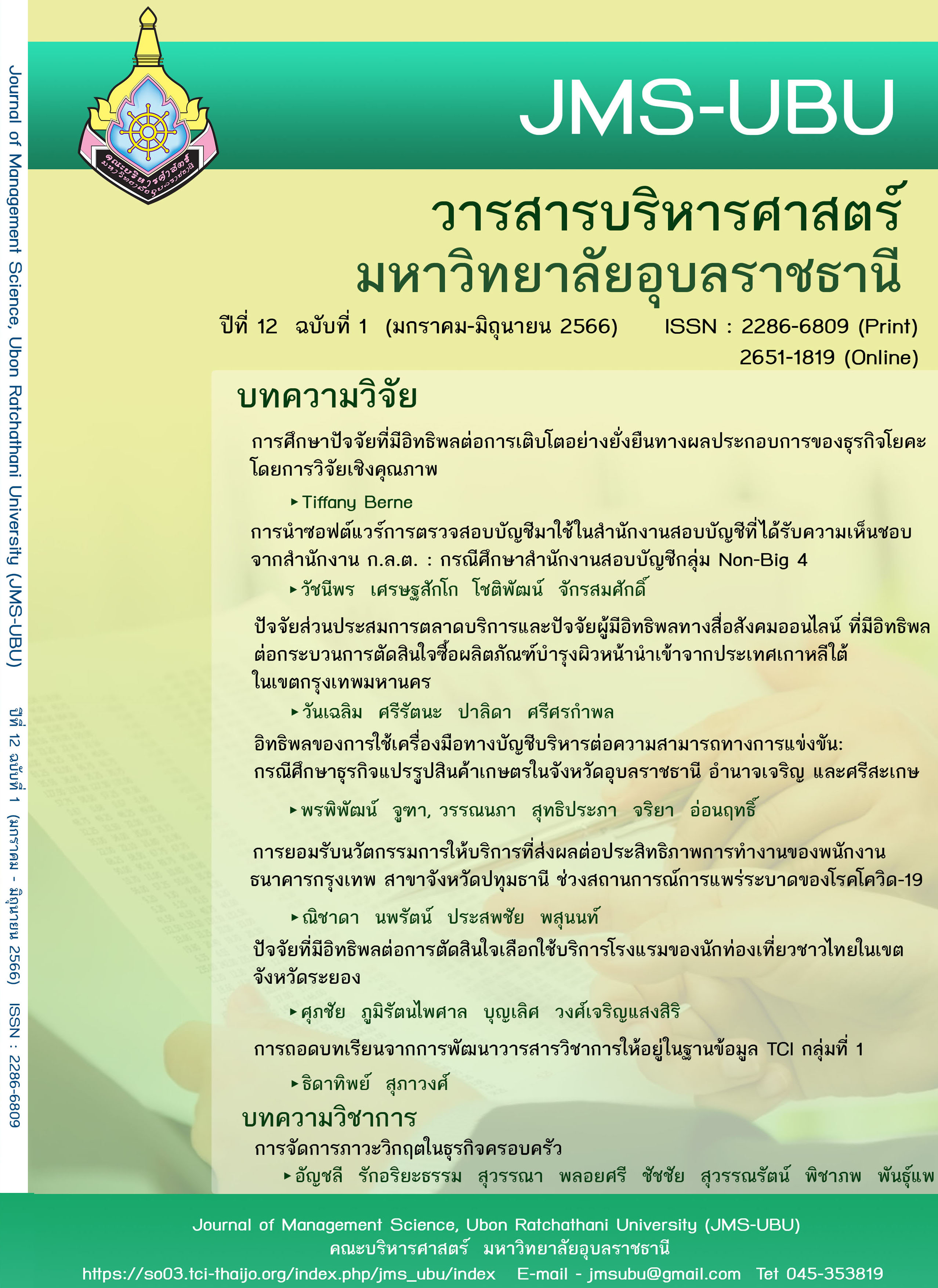การยอมรับนวัตกรรมการให้บริการที่ส่งผลต่อประสิทธิภาพการทำงานของพนักงานธนาคารกรุงเทพ สาขาจังหวัดปทุมธานี ช่วงสถานการณ์การแพร่ระบาด ของโรคโควิด-19
Main Article Content
บทคัดย่อ
การศึกษาเรื่อง การยอมรับนวัตกรรมการให้บริการที่ส่งผลต่อประสิทธิภาพการทำงานของพนักงานธนาคารกรุงเทพ สาขาจังหวัดปทุมธานี ช่วงสถานการณ์การแพร่ระบาดของโรคโควิด-19 มีวัตถุประสงค์ เพื่อศึกษาระดับ การยอมรับนวัตกรรมการให้บริการที่ส่งผลต่อประสิทธิภาพการทำงานของพนักงานธนาคารกรุงเทพ สาขาจังหวัดปทุมธานี ช่วงสถานการณ์การแพร่ระบาดของโรคโควิด-19 และเพื่อวิเคราะห์ความสัมพันธ์ระหว่างการยอมรับนวัตกรรมการให้บริการและประสิทธิภาพการทำงานของพนักงานธนาคารกรุงเทพ สาขาจังหวัดปทุมธานี ช่วงสถานการณ์การแพร่ระบาดของโรคโควิด-19 การศึกษาครั้งนี้ เป็นการวิจัยแบบผสมผสาน (Mixed-Methods) ในรูปแบบขั้นตอนการดำเนินงานวิจัย โดยการทำเชิงปริมาณ ด้วยวิธีการสุ่มแบบโควตา ตามสาขาของธนาคารกรุงเทพ ในจังหวัดปทุมธานี จำนวน 26 สาขา เป็นจำนวน 160 ตัวอย่างและตามด้วยเชิงคุณภาพ ใช้วิธีการเลือกแบบเจาะจง ตามการเลือกตัวอย่างแบบมีเกณฑ์ โดยเลือกผู้ให้ข้อมูลหลักที่มีประสบการณ์ในการทำงานธนาคารกรุงเทพมากกว่า 5 ปีและมีการประเมินวัดผลของธนาคารในปี พ.ศ. 2563 ในระดับดีเยี่ยม จำนวน 10 คน ประกอบไปด้วย ผู้จัดการสาขาและรองผู้จัดการจำนวน 5 คนและพนักงานสาขาจำนวน 5 คน เครื่องมือที่ใช้ในการศึกษา คือ แบบสอบถามและใช้แบบสัมภาษณ์แบบกึ่งโครงสร้าง สถิติที่ใช้ในการวิเคราะห์ข้อมูล ได้แก่ การแจกแจงความถี่ ร้อยละ ค่าเฉลี่ย ค่าเบี่ยงเบนมาตรฐาน ทดสอบสมมติฐานด้วยสถิติการวิเคราะห์ถดถอยพหุคูณ ที่ระดับนัยสำคัญทางสถิติที่ 0.05
ผลการศึกษาพบว่า 1) พนักงานธนาคารกรุงเทพสาขาจังหวัดปทุมธานี ส่วนใหญ่เป็นเพศหญิง มีอายุระหว่าง 25-35 ปีและมีประสบการณ์ทำงาน 7 - 10 ปี 2) ผลการวิเคราะห์ข้อมูลปัจจัยที่ส่งผลต่อประสิทธิภาพ การทำงานของพนักงานธนาคารกรุงเทพสาขาจังหวัดปทุมธานี ช่วงสถานการณ์การแพร่ระบาดของโรคโควิด-19 ประกอบด้วย 3 ด้าน พบว่า โดยรวมอยู่ในระดับเห็นด้วย เมื่อพิจารณาเป็นรายด้าน พบว่า ด้านความง่ายในการใช้งาน มีค่าเฉลี่ยมากที่สุด รองลงมา คือ ด้านการรับรู้ถึงประโยชน์และด้านปัจจัยสนับสนุนสภาพแวดล้อมภายในองค์กร ตามลำดับ และ 3) การวิเคราะห์ข้อมูลประสิทธิภาพการทำงานของพนักงานธนาคารกรุงเทพสาขาจังหวัดปทุมธานี
ช่วงสถานการณ์การแพร่ระบาดของโรคโควิด-19 ประกอบด้วย 3 ด้าน ได้แก่ ด้านเวลา ด้านคุณภาพของงานและด้านปริมาณงาน โดยเรียงลำดับจากค่าเฉลี่ยมากไปหาน้อย
Downloads
Article Details

อนุญาตภายใต้เงื่อนไข Creative Commons Attribution-NonCommercial-NoDerivatives 4.0 International License.
เอกสารอ้างอิง
กันต์ฤทัย คลังพหล. (2563). การวิจัยแบบผสมวิธี. วารสารบัณฑิตศึกษา มหาวิทยาลัยราชภัฏวไลยอลงกรณ์ ในพระบรมราชูปถัมภ์, 14(1), 235-256.
จิตระวี ทองเถา. (2564). นวัตกรรมทางการเงินที่มีอิทธิพลต่อการตัดสินใจใช้บริการธนาคารพาณิชย์ในยุคการระบาดของไวรัส COVID-19. วารสารสหวิทยาการมนุษยศาสตร์และสังคมศาสตร์, 4(1), 214-224.
ฐนิชา คงประดิษฐ์ และ ปรีชา คำมาดี. (2563). การบริหารทรัพยากรมนุษย์เพื่อขับเคลื่อนเศรษฐกิจในยุคไทยแลนด์ 4.0. วารสารบัณฑิตศึกษามหาจุฬาขอนแก่น, 7(3), 45-60.
นิชนันท์ อ่อนรัตน์. (2561). นโยบายการส่งเสริมการท่องเที่ยวเชิงวัฒนธรรมในจังหวัดอุบลราชธานี. วารสารรังสิตบัณฑิตศึกษาในกลุ่มธุรกิจและสังคมศาสตร์, 4(2), 228-241.
บัณฑิต ชวนขุนทด. (2561). การยอมรับเทคโนโลยีและคุณภาพการบริการทางอิเล็กทรอนิกส์ที่มีผลต่อความพึงพอใจในการใช้แอปพลิเคชัน เวียบัส (Viabus) ของประชาชนในเขตจังหวัดปทุมธานี. สืบค้นเมื่อ 21 ตุลาคม 2564, จาก https://mmm.ru.ac.th/MMM/IS/twin-6/sec1/6014154025.pdf
บุญเลิศ กมลชนกกุล. (2562). เปลี่ยนองค์กรสู่ดิจิทัลเริ่มต้นที่ “คน”. สืบค้นเมื่อ 22 ตุลาคม 2564, จาก https://www.efinancethai.com/MoneyStrategist/MoneyStrategistMain.aspx?id=cWR3SFpjOUF3a009
พิชญาพร พีรพันธุ์ และ ประสพชัย พสุนนท์. (2563). การวิเคราะห์การจัดกลุ่มพฤติกรรมการจัดการความรู้ของบุคลากรสายวิชาการมหาวิทยาลัยราชภัฏแห่งหนึ่ง. วารสารการจัดการและการพัฒนา มหาวิทยาลัยราชภัฏอุบลราชธานี, 7(2), 75-86.
วรรณพร อินทมุสิก. (2559). การศึกษา พฤติกรรมการใช้ และผลที่ได้รับต่อชีวิตและจิตใจจากแอพพลิเคชันไลน์ของกลุ่มผู้สูงอายุสมาคมบ้านปันรัก. (การค้นคว้าอิสระปริญญามหาบัณฑิต). มหาวิทยาลัยกรุงเทพ, คณะนิเทศศาสตร์.
วรวีร์ บุญคง. (2563). การปรับตัวในการทำงานมีผลต่อประสิทธิภาพในการปฏิบัติงานของพนักงานธนาคารสานักงานใหญ่เอกชนแห่งหนึ่ง. (บทความวิชาการค้นคว้าอิสระ โครงการบริหารธุรกิจมหาบัณฑิต เพื่อความเป็นเลิศ). มหาวิทยาลัยรามคำแหง, คณะบริหารธุรกิจ.
วิภาวรรณ เส็งสาย. (2561). ความสัมพันธ์เชิงสาเหตุของปัจจัยบางประการที่ส่งผลต่อประสิทธิภาพการทำงานของพนักงานในบริษัทผู้ผลิตเครื่องดื่มแห่งหนึ่งในพื้นที่จังหวัดนครปฐม. (วิทยานิพนธ์ปริญญามหาบัณฑิต). มหาวิทยาลัยศิลปากร, คณะวิทยาการจัดการ.
หิรัญญิการ์ ลาสา. (2560). ปัจจัยที่มีผลต่อประสิทธิภาพการทำงานเป็นทีมของพนักงานธนาคารเพื่อการเกษตรและสหกรณ์การเกษตร จังหวัดอุบลราชธานี. (การค้นคว้าอิสระปริญญามหาบัณฑิต). มหาวิทยาลัยอุบลราชธานี, คณะบริหารศาตร์.
อุบลวรรณ เอกทุ่งบัว. (2557). ปัจจัยที่มีผลต่อประสิทธิภาพในการปฏิบัติงานของบุคลากรสายสนับสนุนและช่วยวิชาการของคณะสัตวแพทยศาสตร์ มหาวิทยาลัยเกษตรศาสตร์. (วิทยานิพนธ์ปริญญามหาบัณฑิต). มหาวิทยาลัยเกษตรศาสตร์, บัณฑิตวิทยาลัย.
Caputo, F., Garcia-Perez, A., Cillo, V., & Giacosa, E. (2019). A knowledge-based view of people and technology: Directions for a value co-creation-based learning organization. Journal of Knowledge Management, 23(7), 1314-1334.
Creswel, J, W., & Plano Clark, V. L. (2018). Designing and Conducting Mixed Methods Research (3rd ed.). Los Angeles: SAGE Publications, Inc.
Davis, F. D. (1989). Perceived usefulness, perceived ease of use, and user acceptance of information technology. MIS Quarterly, 13(3), 319-340.
Fatimah-Salwa, A. H, Mohamad-Azahari, A., & Joni-Tamkin, B. (2013). Success factors of successful microcredit entrepreneurs: Empirical evidence from Malaysia. International Journal of Business and Social Science, 4(5), 153-159.
Fishbein, M. A., & Ajzen, I. (1975). Belief, Attitude, Intention and Behavior: An Introduction to Theory and Research. Boston: Addison-Wesley, Reading, MA.
Goodell, J. W. (2020). COVID-19 and finance: Agenda for future research. Finance Research Letters, 35. DOI: 10.1016/j.frl.2020.101512
Mckinsey & Company. (2016). Cutting through the FinTech noise: Markers of success, Imperatives for Banks. Retrieved October 21, 2021, from https://www.mckinsey.com/~/media/mckinsey/industries/financial%20services/our%20insights/cutting%20through%20the%20noise%20around%20financial%20technology/cutting-through-the-fintech-noise-full-report.ashx
Peterson, E., & Plowman, E. (1953). Business Organization and Management. Homewood: Richard D. Irwin, Inc.
Robbins, S. P. (1990). Organization Theory: Structure Design and Application. New Jersey: Prentice-Hall.
Rovinelli, R. J., & Hambleton, R. K. (1977). On the use of content specialists in the assessment of criterion-referenced test item validity. Tijdschrift Voor Onderwijs Research, 2, 49-60.
Taleb, N., N. (2007). The Black Swan: The Impact of the Highly Improbable. New York: Random House.
Vijayasarathy, L. R. (2004). Predicting consumer intentions to use online shopping: The case for an augmented technology acceptance model. Information and Management, 41(6), 747-762.
World Health Organization. (2020). Laboratory testing for coronavirus disease 2019 (COVID-19) in suspected human cases: Interim guidance. Retrieved October 21, 2021, from https://apps.who.int/iris/bitstream/handle/10665/331329/WHO-COVID-19-laboratory-2020.4-eng.pdf?sequence=1&isAllowed=y
Wu, J. N., & Liu, J. (2007). Construction on performance evaluation system of financial expenditure based on logic model: Taking the agricultural expenditure as an example. Journal of Zhongnan University of Economics and Law, 2, 69-74.
Yamane, T. (1973). Statistics: An Introductory Analysis (3rd ed.), New York: Harper and Row.
Yusuf M., & Ichsan R. N. (2021). Analysis of banking performance in the aftermath of the merger of bank Syariah Indonesia in COVID 19. International Journal of Science, Technology & Management, 2(2), 472-478.

